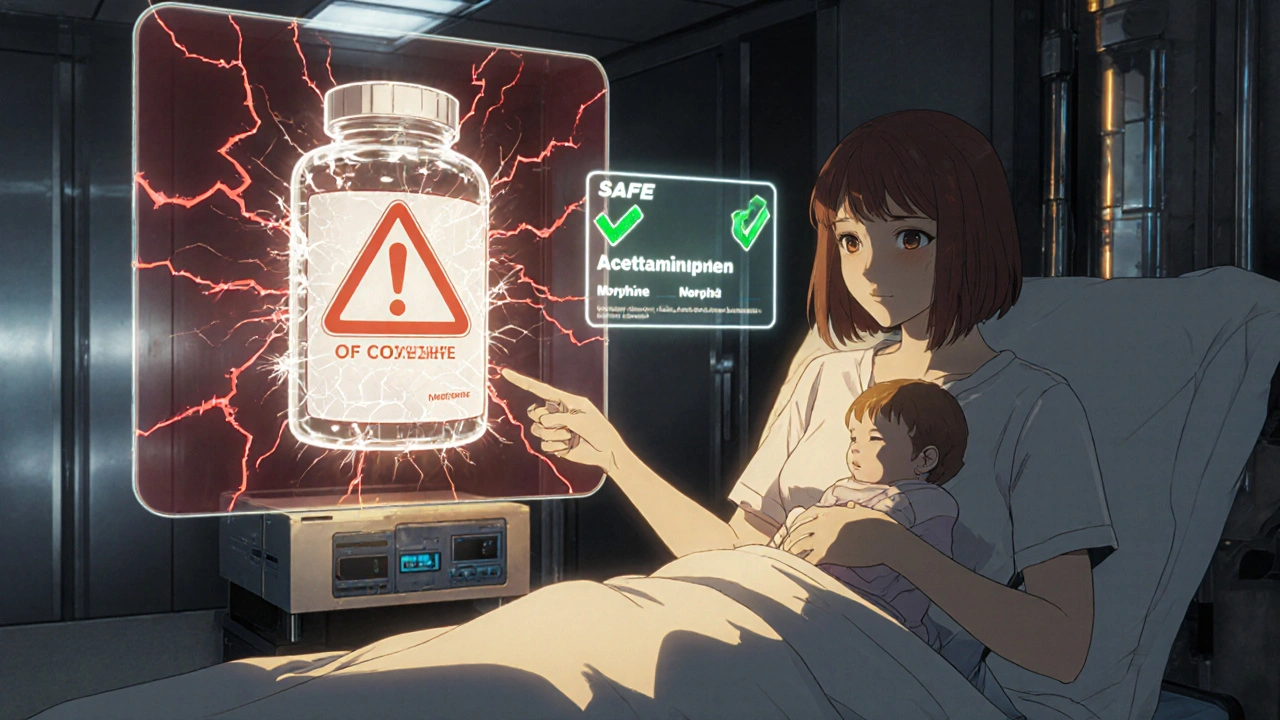Managing postpartum pain while breastfeeding doesn’t mean choosing between comfort and safety
You just gave birth. Your body is healing-maybe from a vaginal tear, an episiotomy, or a C-section. Pain is normal. But now you’re also nursing, and you’re wondering: which pain meds are safe? You don’t want to suffer, but you also don’t want to risk your baby’s health. The good news? Most common pain relievers are perfectly safe. The bad news? Some widely prescribed drugs can be dangerous-and many doctors still don’t tell you this.
First-line choices: acetaminophen and ibuprofen are your safest bets
When it comes to postpartum pain, acetaminophen (Tylenol) and ibuprofen (Advil, Motrin) are the gold standard. Both pass into breast milk in tiny amounts-less than 1% of your dose-and studies show no harm to babies when used as directed.
Acetaminophen peaks in breast milk about 1 to 2 hours after you take it, then drops quickly. Ibuprofen follows a similar pattern. Neither builds up in your baby’s system. The American College of Obstetricians and Gynecologists (ACOG) and the Academy of Breastfeeding Medicine both list these as first-line options. Even the Michigan OPEN initiative, which helps hospitals cut opioid use, recommends starting with scheduled doses of both, alternating every 3 hours for the first 24 hours after a C-section.
Here’s how to use them effectively: Take 650-1000 mg of acetaminophen every 6-8 hours and 400-600 mg of ibuprofen every 6-8 hours. You can even take them together. No need to time feedings around them. You can nurse right after taking them. No pumping and dumping required.
Why codeine and tramadol are off-limits-even if your doctor prescribes them
Some providers still reach for codeine or tramadol after birth because they’re cheap and widely available. But here’s the truth: the FDA warns against both for breastfeeding mothers. Why?
Codeine turns into morphine in your body. But not everyone processes it the same way. About 1 in 100 white women are “ultra-rapid metabolizers”-their bodies convert codeine into morphine way too fast. That means your breast milk could suddenly contain dangerous levels of morphine. In 2012, the FDA linked codeine to the deaths of two newborns whose mothers took it after delivery. Since then, multiple infant deaths have been tied to this same issue.
Tramadol has the same problem. It turns into M1, a powerful opioid metabolite. In some babies, even a single dose can cause extreme sleepiness, trouble breathing, or even respiratory arrest. The FDA issued a safety alert in 2018 after cases surfaced where babies developed life-threatening symptoms despite moms taking normal doses.
Here’s the kicker: you can’t know if you’re an ultra-rapid metabolizer. Genetic testing exists, but it’s not routine. So even if you’ve taken codeine before without issues, you still risk harming your baby now. The Academy of Breastfeeding Medicine, the ASHP, and ACOG all agree: avoid codeine and tramadol entirely while breastfeeding.
If you need an opioid, morphine is the safest option
Sometimes, ibuprofen and acetaminophen aren’t enough. After a C-section or major repair, you might need something stronger. If that’s the case, morphine is the opioid of choice.
Why? Because babies absorb very little of it from breast milk-only about 0.5% to 1%. Even if it’s in the milk, their guts barely take it in. That’s why the InfantRisk Center and ACOG rank morphine as the safest opioid for nursing moms. It’s also the one most commonly used in hospitals for postpartum pain control.
But timing matters. Don’t take morphine right before nursing. Take it right after a feeding. That gives your body time to clear the drug before the next session. Peak levels in breast milk happen 1-2 hours after you take it, so wait at least 2-3 hours before nursing again if possible.
Other opioids like oxycodone and hydrocodone can be used short-term, but they carry more risk. Oxycodone transfers into milk at 0.1-0.5% of your dose. It’s okay for occasional use, but watch your baby closely for drowsiness, poor feeding, or slow breathing. Never use them longer than 4-6 days.

What about naproxen, indomethacin, or other NSAIDs?
Not all painkillers are created equal. Naproxen and indomethacin are NSAIDs like ibuprofen, but they stick around longer in your system. Their concentration in breast milk can reach 1.5-2% of your dose after 24 hours. That’s not high enough to be dangerous for most full-term babies-but it’s enough to be risky for newborns, especially those under 2 months or born prematurely.
The Breastfeeding Network advises avoiding naproxen and indomethacin in early postpartum weeks. Stick with ibuprofen instead. It clears from your system faster and has a better safety track record for infants.
Also, avoid long-acting or extended-release versions of any painkiller. They keep drug levels steady in your blood-and your milk-for longer. That increases exposure for your baby. Always choose immediate-release formulas when possible.
How to monitor your baby for warning signs
Even with safe medications, you need to watch your baby. Signs of opioid sedation can be subtle. Look for:
- Excessive sleepiness-your baby sleeps more than 3-4 hours at a time without waking to feed
- Difficulty latching or staying latched
- Weak or shallow breathing
- Unusual fussiness or limpness
- Constipation or reduced stooling
If you notice any of these after taking an opioid, skip the next dose and call your pediatrician. Don’t wait. Opioid effects in babies can come on suddenly, even hours after you took the pill. The Breastfeeding Network recommends watching your baby for 24 hours after each dose, especially if it’s your first time using an opioid while nursing.
What to do if you accidentally took codeine or tramadol
If you took one dose of codeine or tramadol before realizing it’s unsafe, don’t panic. A single accidental dose is unlikely to cause harm-but you need to be alert.
Watch your baby closely for the next 24-48 hours. Skip the next dose. Resume acetaminophen and ibuprofen. If your baby shows any signs of drowsiness, breathing trouble, or poor feeding, go to the ER immediately. Bring the medication bottle with you.
Going forward, tell your doctor you’re breastfeeding and ask for alternatives. Most hospitals now have protocols to avoid these drugs. If yours doesn’t, ask for a pharmacist consultation. They can help find safer options.

Don’t pump and dump-unless your doctor says so
For years, moms were told to “pump and dump” for 24 hours after anesthesia or pain meds. That’s outdated. The Academy of Breastfeeding Medicine updated its guidelines in 2021 to remove this advice. Studies show that even after major surgery, less than 1% of most medications end up in breast milk-and almost none of it reaches the baby in harmful amounts.
There’s no need to discard milk unless you’re taking a medication explicitly labeled unsafe (like codeine or tramadol). Pumping and dumping doesn’t speed up clearance-it just makes you more sore and exhausted. Keep nursing. It helps your body heal faster, reduces your pain, and protects your milk supply.
Future options: genetic testing may change the game
Researchers are working on ways to prevent these risks before they happen. Mayo Clinic published a 2023 study showing that testing for the CYP2D6 gene-responsible for metabolizing codeine and tramadol-can identify ultra-rapid metabolizers before prescribing.
Right now, this testing isn’t standard. But if you’ve had a bad reaction to opioids before, or if you have a family history of opioid sensitivity, ask your doctor about it. In the future, this could become routine before any postpartum pain prescription.
Bottom line: You can heal and breastfeed safely
Postpartum pain is real. But you don’t have to suffer-and you don’t have to choose between your baby’s safety and your comfort. Stick with acetaminophen and ibuprofen. Avoid codeine and tramadol at all costs. If you need something stronger, morphine is your safest bet, taken right after nursing. Watch your baby. Trust your instincts. And never be afraid to ask for help.
Most importantly: your pain matters. Your healing matters. Your baby’s health matters. You can have all three.
Can I take ibuprofen while breastfeeding?
Yes, ibuprofen is one of the safest pain medications for breastfeeding mothers. Only about 0.6-0.7% of your dose passes into breast milk, and it doesn’t build up in your baby’s system. You can take it as directed-typically 400-600 mg every 6-8 hours-without needing to time feedings or pump and dump.
Is acetaminophen safe for breastfeeding moms?
Yes, acetaminophen is considered safe and is often recommended as a first-line option. Less than 1% of your dose enters breast milk, and it clears quickly. It’s safe to take every 6-8 hours at doses up to 1000 mg, even right before or after nursing.
Why is codeine dangerous while breastfeeding?
Codeine is converted into morphine in your body, but some people-about 1 in 100-process it too quickly, creating dangerously high morphine levels in breast milk. This can cause life-threatening breathing problems, extreme sleepiness, or even death in infants. The FDA has issued strong warnings against its use during breastfeeding because you can’t predict who will metabolize it dangerously.
Can I take tramadol while breastfeeding?
No. Tramadol is converted into an active metabolite (M1) that can cause severe respiratory depression in nursing infants-even at standard doses. The FDA has explicitly warned that breastfeeding is not recommended while taking tramadol due to multiple documented cases of infant overdose and death.
What’s the safest opioid for breastfeeding moms?
Morphine is the safest opioid option. It transfers into breast milk in very low amounts, and babies absorb less than 1% of it from milk. It’s preferred in hospitals for postpartum pain because of its predictable metabolism and low risk to infants. Take it right after nursing to minimize exposure.
Should I pump and dump after taking pain meds?
No, unless you’ve taken a medication specifically labeled unsafe like codeine or tramadol. For acetaminophen, ibuprofen, or even morphine, pumping and dumping doesn’t improve safety-it just reduces your milk supply and adds stress. Breast milk contains only trace amounts of these drugs, and they’re not harmful to your baby at those levels.
What signs should I watch for in my baby?
Watch for excessive sleepiness (sleeping more than 3-4 hours without feeding), difficulty latching, shallow or slow breathing, limpness, or constipation. These can be signs of opioid sedation. If you notice any, skip the next dose and contact your pediatrician immediately.
Can I use naproxen while breastfeeding?
Naproxen is not recommended as a first choice, especially in the first few weeks after birth. It stays in your system longer and can reach higher levels in breast milk (up to 2% of your dose). Stick with ibuprofen instead. If you must use naproxen, limit it to short-term use and avoid it if your baby is premature or under 2 months old.
